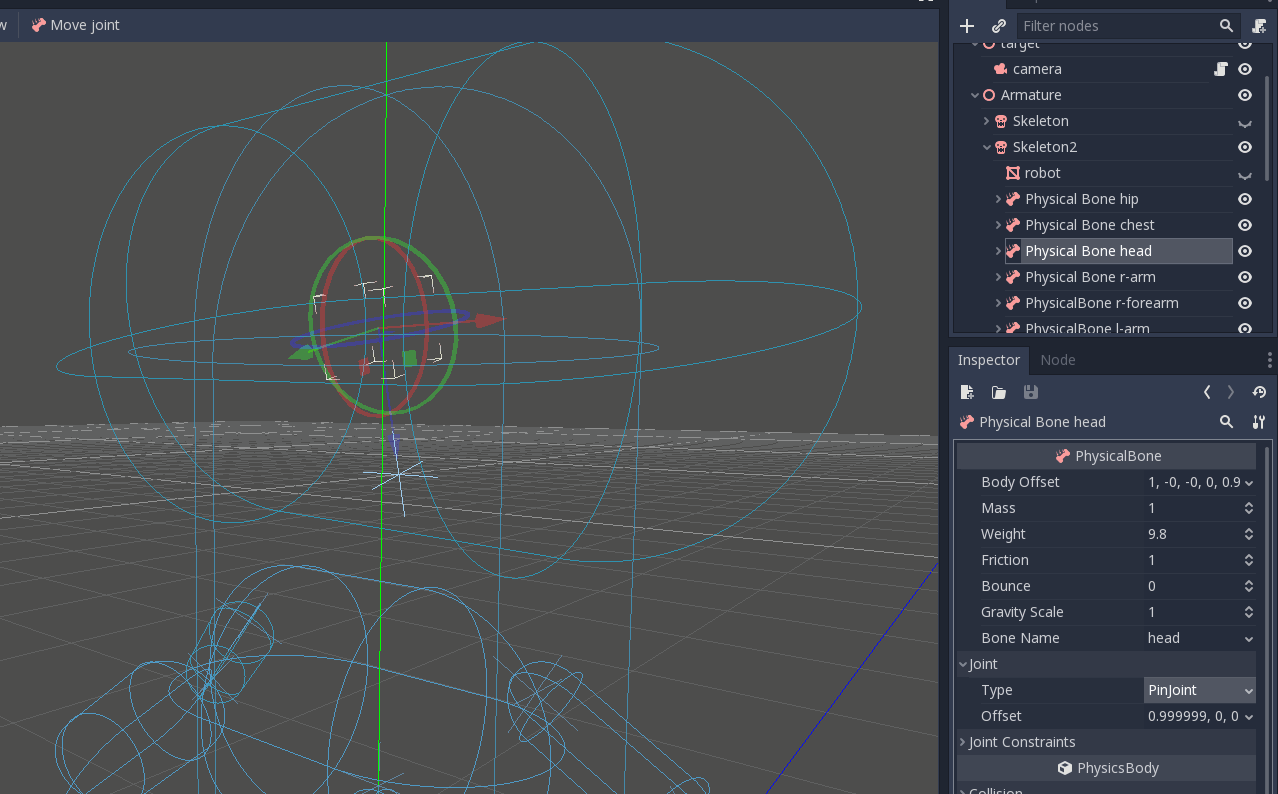Attention: Here be dragons
This is the latest
(unstable) version of this documentation, which may document features
not available in or compatible with released stable versions of Godot.
Checking the stable version of the documentation...
布娃娃系统¶
前言¶
Godot 从 3.1 版本开始支持布娃娃物理。布娃娃依靠物理模拟来创建逼真的程序式动画,它们被用于许多游戏中的死亡动画。
在本教程中,我们将使用 Platformer3D 演示来进行布娃娃的设置。
备注
您可以在 GitHub 上下载Platformer3D演示或使用 Asset Library .
设置布娃娃¶
创建物理骨骼¶
Like many other features in the engine, there is a node to set up a ragdoll: the PhysicalBone3D node. To simplify the setup, you can generate PhysicalBone nodes with the "Create physical skeleton" feature in the skeleton node.
在 Godot 中打开 Platformer 演示项目,然后打开 Robi 场景。选择 Skeleton 节点。顶部栏菜单上显示骨架按钮:

单击它并选择 创建物理骨架 选项。Godot 将为骨架中的每个骨骼生成 PhysicalBone 节点和碰撞形状,并用钉关节将它们连接在一起:

一些生成的骨骼不是必需的:例如 MASTER 骨骼。因此,我们将通过删除它们来清理骨架。
清理骨骼¶
引擎需要模拟的每一个 PhysicalBone 都有性能成本, 所以你要把每一个太小的骨头都去掉, 以便所有的实用骨头在模拟中发挥作用.
例如, 如果我们拿一个人形动物来说, 不希望每个手指都有物理骨骼. 可以用一根骨头代替整个手, 或者用一根骨头代替手掌, 一根骨头代替拇指, 最后一根骨头代替其他四个手指.
删除这些物理骨骼:MASTER、waist、neck、headtracker。这样就有了一个优化的骨架,使其更容易控制布娃娃。
碰撞形状调整¶
接下来的任务是调整碰撞形状和物理骨骼的大小, 以匹配每个骨骼应该模拟的身体部位.

关节调整¶
一旦你调整了碰撞形状,布娃娃就差不多准备好了。只需要调整钉关节以获得更好的模拟效果。PhysicalBone 节点在默认情况下有一个不受限制的钉关节。要改变钉关节,请选择 PhysicalBone 并在 Joint 部分改变约束类型。在那里,你可以改变约束的方向和限制。

这是最终效果:

模拟布娃娃¶
布娃娃现在可以使用了。要开始模拟并播放布娃娃动画,您需要调用 physical_bones_start_simulation 方法。将脚本附加到骨架节点并在 _ready 方法中调用该方法:
func _ready():
physical_bones_start_simulation()
要停止模拟, 请调用 physical_bones_stop_simulation() 方法.

您还可以将模拟限制为仅几个骨骼。为此,请将骨骼名称作为参数传递。这是部分布娃娃模拟的一个示例:

碰撞层与遮罩¶
Make sure to set up your collision layers and masks properly so the CharacterBody3D's capsule doesn't get in the way of the physics simulation:

有关更多信息, 请阅读 物理介绍.